Dynabook DCE45380A Tri-Mode Dual-Band Analog/PCS Phone User Manual CDM9155GPXFCC cover
Toshiba Corporation Tri-Mode Dual-Band Analog/PCS Phone CDM9155GPXFCC cover
Dynabook >
Users Manual

9155GPX
OWNER'S MANUAL
Draft
December 2001
TABLE OF CONTENTS
SAFETY INFORMATION FOR
WIRELESS HANDHELD PHONES ...........…………........... 1
SAR INFORMATION ......................................…………....... 2
FUNCTIONS .............................................…………............. 3
GETTING STARTED ................................…………............. 5
BASIC OPERATION .......................................…………....... 6
Placing Calls .......................................………….............. 6
Receiving Calls ................................…………................. 8
During Calls..........................................…………............. 9
Standby.................................................…………............. 11
OPERATING PROCEDURES ........................…………....... 12
APPLICANT: TOSHIBA CORPORATION
TRANSCEIVER TYPE: CJ6DCE45380A
EXHIBIT Type “User Manual”

1
SAFETY INFORMATION FOR
WIRELESS HANDHELD PHONES
SAFETY INFORMATION FOR
WIRELESS HANDHELD PHONES
Read this information before using your handheld
portable Cellular Telephone.
Your wireless handheld portable telephone is a low
power radio transmitter and receiver. When it is ON, it
receives and also sends out radio frequency (RF) sig-
nals.
FCC RF EXPOSURE INFORMATION
In August 1996, the Federal Communications Commis-
sion (FCC) of the United States, with its action in Re-
port and Order FCC 96-326, adopted an updated safety
standard for human exposure to radio frequency (RF)
electromagnetic energy emitted by FCC regulated trans-
mitters. Those guidelines are consistent with the safety
standard previously set by both U.S. and international
standards bodies. The design of this phone complies
with the FCC guidelines and these international stan-
dards.
Use only the supplied or an approved antenna. Unau-
thorized antennas, damaged antennas, modifications,
or attachments could impair call quality, damage the
phone, or result in violation of FCC regulations. Please
contact your local dealer for replacement antenna.
Body-worn Operation
This device was tested for typical body-worn operations
with the BC-9100 belt-clip and LB-9100 holster mod-
els, offered by Audiovox as an accessory to this phone,
and found to comply with FCC RF exposure require-
ments. Third-party belt-clips, holsters and similar ac-
cessories should be avoided, as they have not been
tested and may not comply with FCC RF exposure lim-
its.
For more information about RF exposure, please visit
the FCC website at www.fcc.gov .

2
phones used by the public is 1.6 watts/kg (W/kg) averaged
over one gram of tissue. The standard incorporates a sub-
stantial margin of safety to give additional protection for the
public and to account for any variations in measurements.
SAR INFORMATION
SAR INFORMATION
THIS MODEL PHONE MEETS THE GOVERNMENT’S RE-
QUIREMENTS FOR EXPOSURE TO RADIO WAVES.
Your wireless phone is a radio transmitter and receiver. It is
designed and manufactured not to exceed the emission limits
for exposure to radiofrequency (RF) energy set by the Fed-
eral Communications Commission of the U.S. Government.
These limits are part of comprehensive guidelines and estab-
lish permitted levels of RF energy for the general population.
The guidelines are based on standards that were developed
by independent scientific organizations through periodic and
thorough evaluation of scientific studies. The standards include
a substantial safety margin designed to assure the safety of
all persons, regardless of age and health.
The exposure standard for wireless mobile phones employs a
unit of measurement known as the Specific Absorption Rate,
or SAR. The SAR limit set by the FCC is 1.6 W/kg.* Tests for
SAR are conducted with the phone transmitting at its highest
certified power level in all tested frequency bands. Although the
SAR is determined at the highest certified power level, the ac-
tual SAR level of the phone while operating can be well below
the maximum value. This is because the phone is designed to
operate at multiple power levels so as to use only the power
required to reach the network. In general, the closer you are to
a wireless base station antenna, the lower the power output.
Before a phone model is available for sale to the public, it
must be tested and certified to the FCC that it does not ex-
ceed the limit established by the government-adopted require-
ment for safe exposure. The tests are performed in positions
and locations (e.g., at the ear and worn on the body) as re-
quired by the FCC for each model. The highest SAR value for
this model phone when tested for use at the ear is 1.45 W/kg
and when worn on the body, as described in this user guide,
is 0.72 W/kg. (Body-worn measurements differ among phone
models, depending upon available accessories and FCC re-
quirements). While there may be differences between the SAR
levels of various phones and at various positions, they all meet
the government requirement for safe exposure.
The FCC has granted an Equipment Authorization for this
model phone with all reported SAR levels evaluated as in com-
pliance with the FCC RF exposure guidelines. SAR informa-
tion on this model phone is on file with the FCC and can be
found under the Display Grant section of http://www.fcc.gov/
oet/fccid after searching on FCC ID CJ6DCE45380A.
Additional information on Specific Absorption Rates (SAR) can
be found on the Cellular Telecommunications & Internet As-
sociation (CTIA) web-site at http://phonefacts.net.
*In the United States and Canada, the SAR limit for mobile

3
FUNCTIONSFUNCTIONS
External View
Rm
ABCDEFGHIJKL
MNOPQRSTUVWX
YZ1234567890
2
13
ABC DEF
5
46
JKL
GHI
PQRS
MNO
8
79
TUV WXYZ
0
CLR
Rc
l
F
V
Retractable
Whip Antenna
Incoming Call
& Charging
Indicator (LED)
Earpiece
Power/Data
Connector
Graphic
Display
End Key with
Power On/Off
Clear Key
Soft Key 2
Multi Function
Key
Up-arrow
Recall
Function
Down-arrow
Microphone
Voice Activated
Dialing &
Space Key
Power
Indicator
Receiving
Signal
Strength
Indicator
Digital
Mode
Indicator
IN USE
Indicator
Roaming
Indicator
Message
Indicator
Battery Level
Indicator
Send Key
Voice Mail &
Speakerphone
One-Touch
Emergency Key
Digit Keys
Vibrating &
Shift Key
Vibrating
Indicator
Soft Key 1
Message
Access Key
Next Key
Earphone
Mic Jack
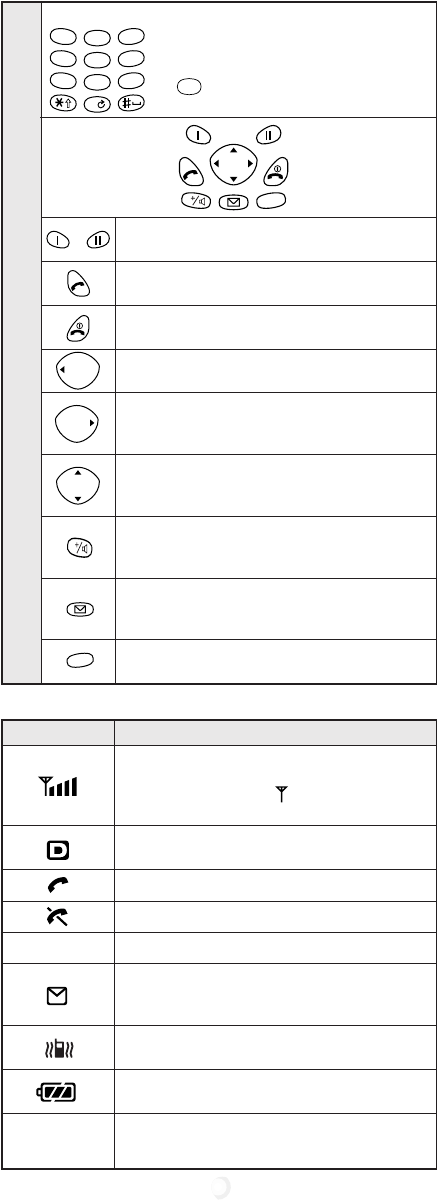
4
Function of Keys
LCD Display Indication
Key- Board Arrangement
Digit Keys
Function Keys
Soft Keys. To function as shown in the
bottom line on the display.
SEND Key. To originate or answer a call.
END Key. To terminate a call and to turn
the phone ON/OFF.
To recall phone numbers from memory.
Also used as left-arrow key.
To be used with other keys to activate
various special features. Also used as
right-arrow key.
To control the volume of Ringer, Key Tone
and Earpiece/Speakerphone.
Also used as up/down-arrow keys.
To access your Voice Mail with only one
key (see page 62) and to activate Speak-
erphone mode (see page 29).
To review Text Messages or to learn how
many Voice Messages are in your Voice
Mailbox (see page 57).
To clear digits from the display or from a
memory location.
2
13
ABC DEF
5
46
JKL
GHI
PQRS
MNO
8
79
TUV WXYZ
0
ABCDEFGHIJKL
MNOPQRSTUVWX
YZ1234567890
Items Descriptions
Receiving Signal Strength Indicator.
The number of lines indicates the received
Signal Strength, and
is also used as a
POWER ON Indicator.
Digital Mode Indicator. To indicate the
phone is operating in digital mode.
A call is in progress.
The phone is out of Service Area.
The phone is out of the Home Area.
Message Indicator. To indicate that new
Text Messages are stored in memory or new
Voice Messages are in your Voice Mailbox.
Vibrating Indicator. To indicate that the
vibrating alert is active.
Battery Level Indicator.
Monitors the battery charge condition.
Graphic full-dot matrix display with flexible
font size in 3 to 7 lines.
Rm
To enter Telephone Numbers.
To enter letters and symbols (see
page 32).
1
is also used for One-Touch
Emergency feature.
CLR
Rc
l
F
V
Rc
l
F
CLR
V

5
GETTING STARTEDGETTING STARTED
Turning the Phone On/Off
Press and hold . All the indicators and the display
will light momentarily, and a tone will be heard. The
indicator will be displayed while the phone is on.
To turn the phone off, press and hold .
Antenna Position
The antenna can be used in its fully extended or fully re-
tracted position only. It is recommended that the antenna
should be fully extended for optimum performance and
signal strength or while operating in poor signal areas.
Receiving Signal Strength Indicator
(
)
The number of lines shown by this icon indicates the
strength of the signal your phone is receiving. Four lines
indicates maximum signal strength. The number of lines
may change as you move with the phone to represent
the changing signal strength. If the signal is not strong
enough to place a call, “ ” will appear on the display.
Battery Level Indicator
You can always monitor the battery charge condition
with the constant battery level indicator. The number of
blocks indicates the battery conditions as follows:
Full charge
Low charge
Flashing indicates discharged.
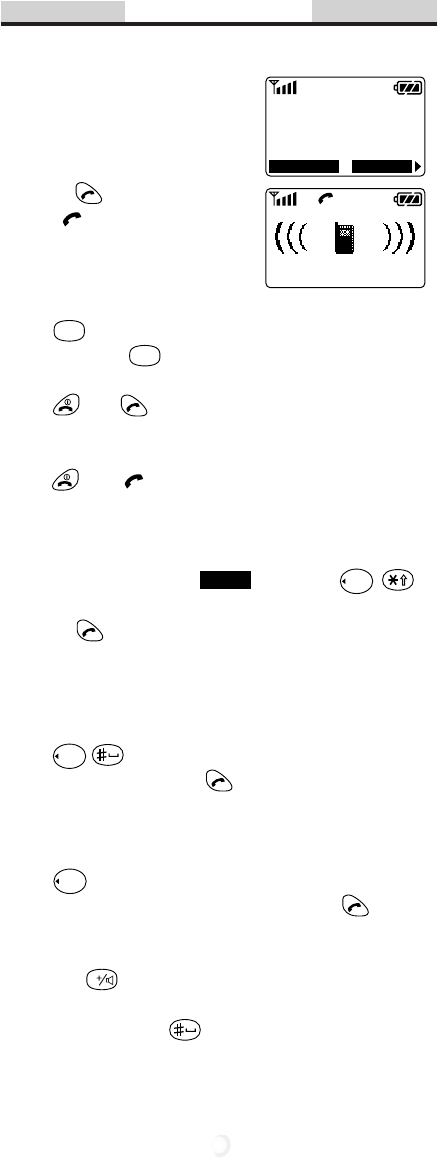
6
BASIC OPERATIONBASIC OPERATION
Placing Calls
To Place a Call
1. Enter the phone number.
(A maximum of 32 digits will
be displayed.)
2. Press .
The indicator will appear
on the display.
• To Correct a Number
Press
CLR
to clear the last digit.
Press and hold
CLR
to erase all the digits entered.
•
If the Call Fails to Go Through
Press and to redial the number.
To Terminate a Call
Press . The indicator will no longer appear in the
display.
Last Number Redial
1. Press the key under
Redial
, or press
Rcl
to
recall the last number dialed.
2. Press to place the call.
See Call History on page 54 for details. See also Re-
dial Soft Key (F04) on page 89.
To Dial the Last Number Received
Press
Rcl
to recall the last number with Caller ID
you received, then press .
See Call History on page 54 for details.
Phonebook Dialing
Press
Rcl
and enter an address (01 to 99) to recall a
number from your phonebook, then press .
See Phonebook Recall on page 43 for details.
Tip: The
V
key will be used for Voice Mail access. See
page 62.
Tip: Press and hold for Voice Activated Dialing. See
page 53.
123-456-7890
MenuSTO
Calling...
123-456-7890
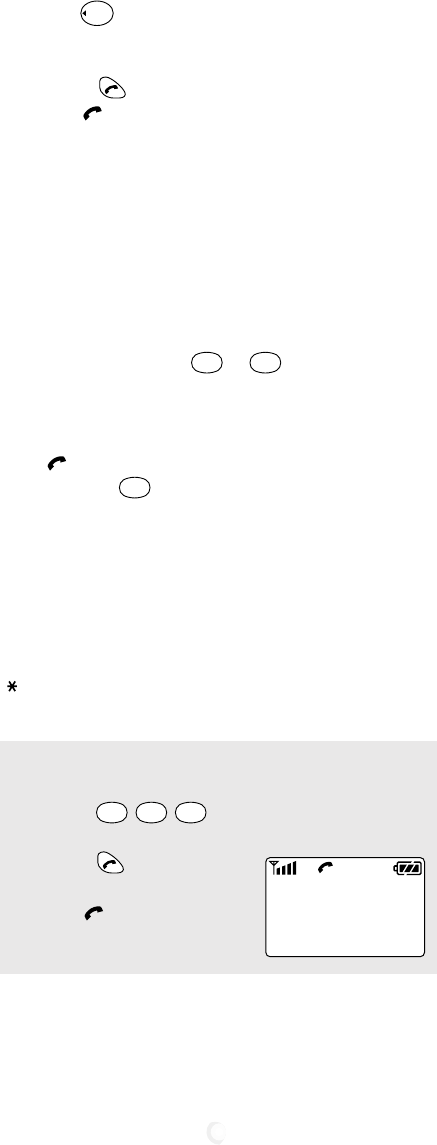
7
Speed Dialing
If you know the phonebook address of the telephone
number that you want to call, you may place a call with-
out using
Rcl
.
1. Enter the one or two digits of your Phonebook ad-
dress (1 to 9 or 10 to 99).
2. Press . The phone number will be displayed.
The indicator will be displayed and the call will
be placed.
Note: If two telephone numbers are stored in the address,
the Primary Number will be dialed.
Quick Dialing
When this feature is on, the Primary number in your
Phonebook address 02 to 09 can be dialed with just
one push of the key. See Quick Dialing (F01) on page
89 to turn this feature on/off.
1. Press a digit key (
2
ABC
to
9
WXYZ
) for more than one
second.
2. The number in your phonebook is automatically
dialed. The phone number will be displayed. The
indicator will light.
Note: The key
1
is not for Quick Dialing, but for One-
Touch Emergency Call, page 27.
Emergency Call
This feature permits you to place an emergency call even
if your telephone is in “Phone Lock”, “Keypad Lock” or
“Restrict” mode. Up to 3 numbers can be programmed as
Emergency numbers. The emergency numbers “911” and
“911” are already preprogrammed. See To Change
Emergency Numbers (F62) on page 85.
Example: To Call 911 in “Phone Lock” or “Key-
pad Lock” mode.
1. Enter
9
WXYZ
1
1
. The “911” will not be dis-
played.
2. Press .
The “911” will be displayed.
The indicator will light,
and the call will be placed.
Calling...
Emergency
911
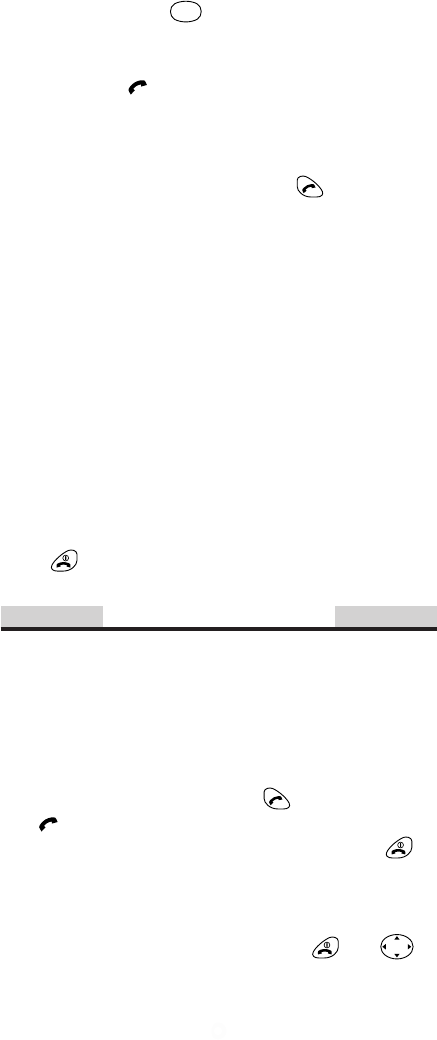
8
One-Touch Emergency Call
This feature permits you to dial an emergency number
by a single key stroke, even in the “Phone Lock” or
“Restrict” mode. This feature can be turned off to pre-
vent unintentional calls to the emergency number.
See To Turn On/Off One-Touch Emergency Call Fea-
ture (F63) on page 85.
1. Press and hold
1
for more than 2 seconds. The
number in emergency memory location “1” will be
dialed.
2. Then the indicator will be displayed and the
call will be placed. (The factory preset number is
“911”.)
Note: This feature cannot be used if the Keypad Lock is on.
You need to dial all the digits and .
Emergency Call Mode
When you dial one of the 3 preprogrammed emergency
numbers, your phone will enter the Emergency Call
Mode. In this mode, the phone will attempt to complete
the emergency call using any available cellular system
from which it can obtain service.
After it places an emergency call, the phone will stay in
the Emergency Call Mode, and will display “Emer-
gency Call Mode, END to exit”. In the Emergency Call
Mode, the phone will attempt to continue to receive
service from the Cellular system that it used to com-
plete the call. The phone will automatically exit the
Emergency Call Mode after 5 minutes or after you
press .
Receiving Calls
The phone sounds an alert or vibrates to alert you of
an incoming call. The phone sounds an alert or vibrates
to alert you of an incoming call. Also, the LED on the
top of the phone will flash.
To Receive a Call
When the telephone rings, press to answer the call.
The indicator will be displayed.
Note: To mute the ringer or stop the vibrating, press .
Any Key Answering
This feature permits you to answer an incoming call by
pressing any key on the key pad except and
Rcl F
.
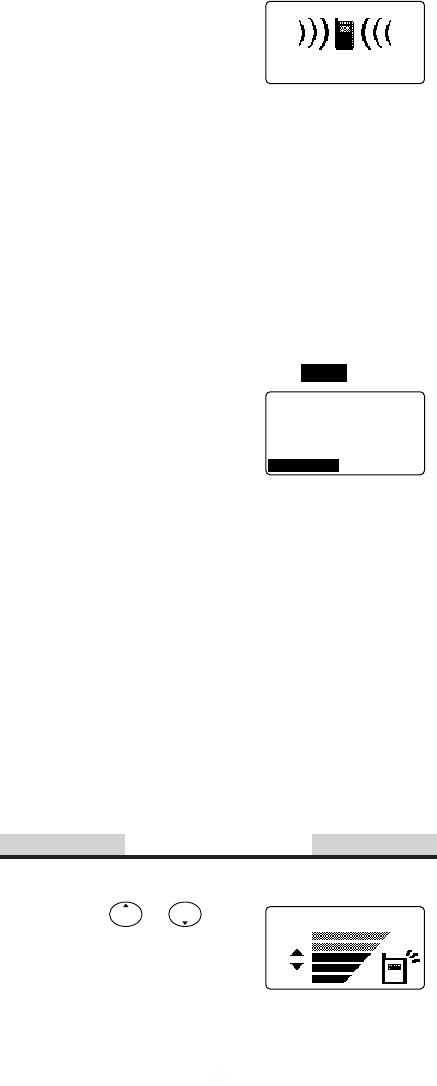
9
Caller ID with Name
This feature allows you to preview in your display the
number and name of the party calling you before you
answer the call. The name is as you programmed it in
your phonebook.
1. When the phone rings, the
Calling Number appears in
the display.
2. The last 10 Caller IDs are stored in the memory
for your review and redial. See Call History on
page 54 for details.
Note: “Number Restricted” or “Number Unavailable” is dis-
played when the Caller ID is restricted or not available.
Automatic Calls-in-Absence Indicator
This feature indicates the number of unanswered incom-
ing calls. The display indicates “Called XX”, the num-
ber of calls (01 to 99) you missed and the LED will blink.
It also indicates the caller number and name of the latest
call, if available. Press the key under
Refer
to view In-
coming Call History.
Depressing any key will clear the
display. See Redial Soft Key
(F04) on page 89.
Ringing Tone with Melody
The 9155GPX offers you 15 styles of ringer tones and
melodies for alerting incoming calls. Ringer volume can
also be adjusted. See Ringer Type Selection (F32) on
page 75 and Ringer Volume Control (F31) on page 75
for setting. See also Vibrating Alert (F8) on page 88.
Distinctive Ringing (Audible Caller ID)
You may program different ringer styles for different
phonebook addresses. See To Store a Ringer Type
with the Phone Number on page 40 for setting.
During Calls
To Adjust the Earpiece Volume
Simply press or to ad-
just Earpiece/Speakerphone
Volume during a call.
Incoming Call
JACK
123-456-7890
Ear/SPK Vol.
Refer
Called 12
May 21 10:25 am
JACK
123-456-7890

10
To Mute a Phone Conversation
There are two ways to mute the microphone during a
call.
1. Press the key under
Mute
, or press
F
F
.
2. Then the screen displays “Phone is muted!”.
3. To return to normal mode, press the key under
Unmute
, or press
F
F
again.
Note: Terminating a call cancels the muting.
Speakerphone Mode (Two-Way)
This feature allows you to engage in a conversation with-
out having to hold the phone.
1. To activate this feature, press
V
during a call.
The screen displays “Speaker ON!”.
2. Press or to adjust the earpiece/speak-
erphone volume.
3. To return to normal mode, press
V
again.
Notes: 1. Terminating a call cancels the speakerphone mode.
2. It is not recommended to use this feature in a noisy
environment.
Automatic Talk Timer
The talk time of the current call will be automatically
displayed. For example, “1H 23M 45S”.
Scratch Pad Dialing
If you enter a telephone number during a call, the num-
ber will be stored in the Scratch Pad memory.
After terminating the call, the number you entered can
be dialed by pressing .
Note: You can deactivate “Sending DTMF” so that keypad
tones will not be transmitted to the calling party. See
Sending DTMF (F34)
on page 75.
Call Waiting
Your service provider may provide Call Waiting service.
When you are on a call, you may hear a beep tone alert-
ing you of another incoming call.
Your phone displays “New Caller” and the new caller’s
name and number. The name is as you programmed it
in your phonebook.
1. Press to answer the new call.
2. Press again to switch between the two calls.
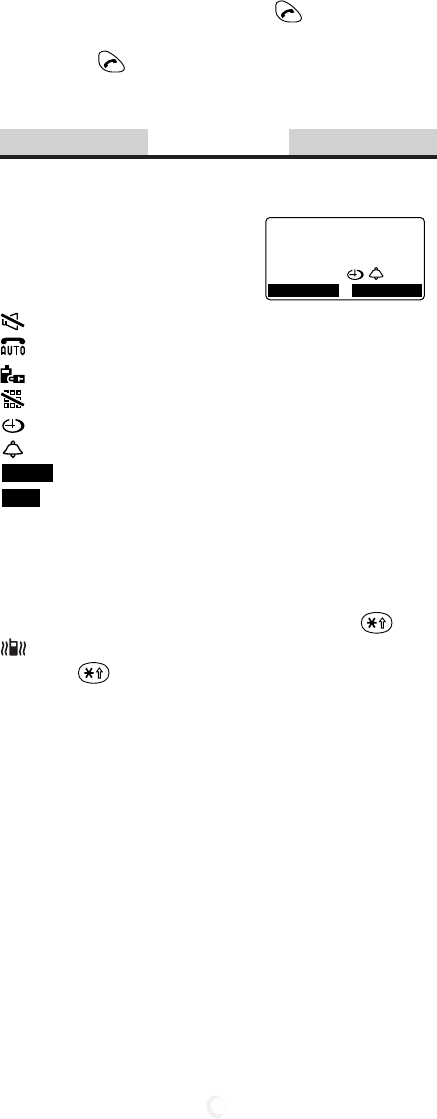
11
Three-Way Calling
Your service provider may provide Three-Way Calling
service. When a call is already in progress, you may
call the third party.
1. Enter a number and press to call the third
party.
2. Press again to connect all three parties.
Ask your service provider for the detailed information.
Standby
Indicators on Standby
Your phone displays date and
time, various settings status, and
soft keys in standby.
: Ringer Volume is in Silent mode. See page 75.
: Automatic Answering is active. See page 89.
: Phone Lock is active. See page 72.
: Keypad Lock is active. See page 71.
: Countdown Timer is active. See page 80.
: Clock Alarm is active. See page 79.
Redial
: See Last Number Redial on page 25.
Web
: See Accessing Internet on page 65.
Note: For displaying date and time, see Clock Indicator (F42)
and Clock Adjustment (F43) on page 79.
Vibrating Alert
To activate Vibrating Alert, press and hold . The
indicator will be displayed. To deactivate it, press
and hold again. See also Vibrating Alert (F8) on
page 88.
Multilingual
Your phone provides multiple languages (English, Span-
ish, French and Portuguese) for displaying the menus
and prompts in the Basic Operation, Phonebook Op-
eration and Function Menu. See Language Selection
(F24) on page 74.
Redial Web
May 21 Mon
3 : 15 pm

12
OPERATING PROCEDURESOPERATING PROCEDURES
Never violate any of the following Rules and Regula-
tions of the FCC when using your Cellular Phone. Such
violations are punishable by fine, imprisonment or both.
• Never use obscene, indecent, or profane lan-
guage.
• Never use your Cellular Phone to send false dis-
tress calls.
• Never wiretap or otherwise intercept a phone call,
unless you have first obtained the consent of the
parties participating in the call.
• Never make any anonymous calls to annoy, ha-
rass, or molest other people.
• Never charge another account without authoriza-
tion, to avoid payment for service.
• Never willfully or maliciously interfere with any
other radio communications.
• Never refuse to yield the line when informed that
it is needed for an Emergency Call. Also, never
take over a line by stating falsely that it is needed
for an emergency.